Paria Canyon Backpacking Guide
Located on the Utah/Arizona border in the Paria Canyon-Vermillion Cliffs Wilderness, backpacking Paria Canyon involves 38 miles of hiking down the meandering riverbed…
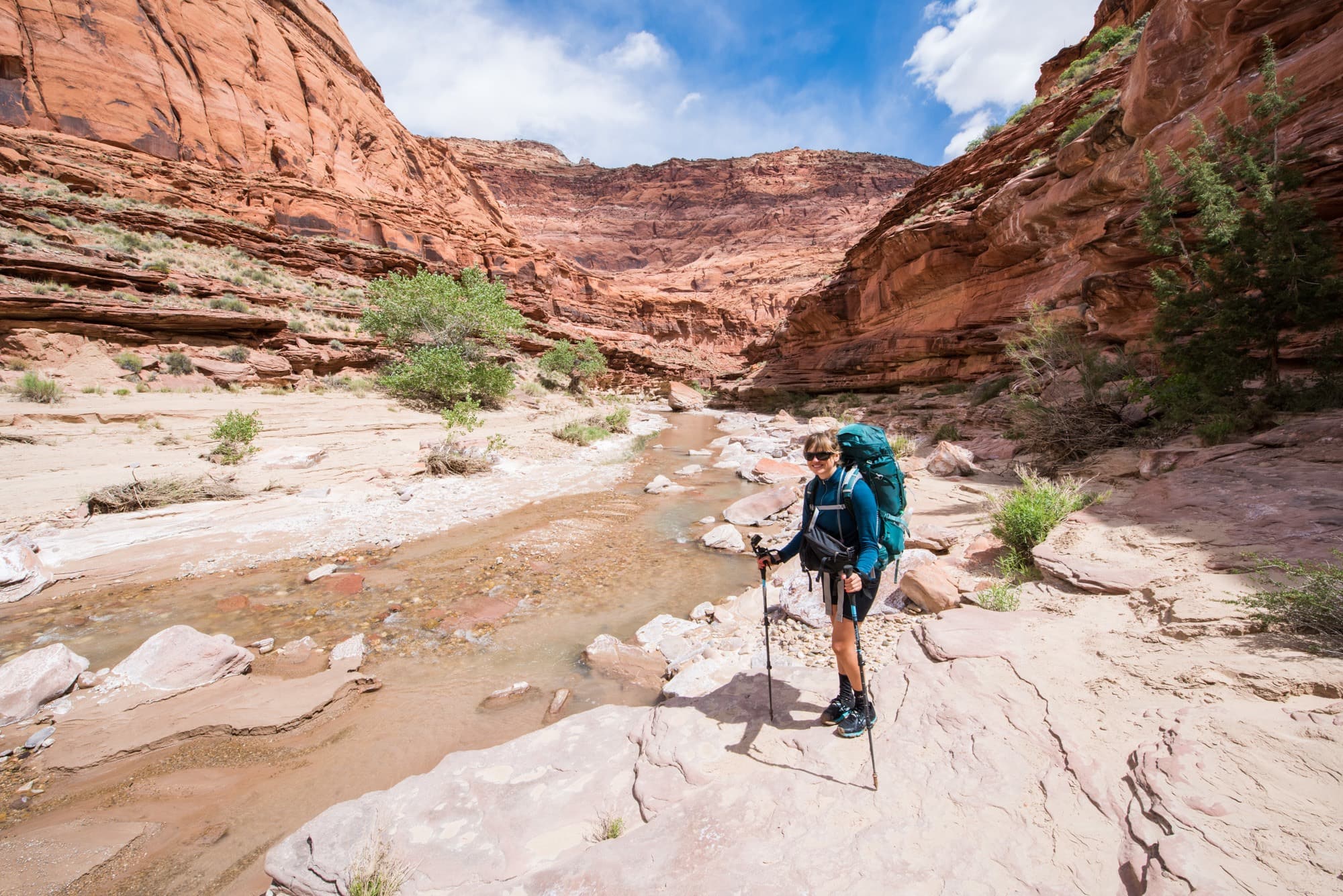
Located on the Utah/Arizona border in the Paria Canyon-Vermillion Cliffs Wilderness, backpacking Paria Canyon involves 38 miles of hiking down the meandering riverbed in-between two enormous walls of Navajo sandstone. I spent four days backpacking through the winding canyon and absolutely loved it.
A Paria Canyon backpacking trip requires wading downriver, with dozens of crossings – in some ways similar to hiking the Narrows in Zion, but more remote and isolated. Your feet will be wet the entire time. Due to the nature of the trail (or lack of trail), the hiking is slow, but it is nothing short of spectacular and worth every ounce of effort. What made it even better was that over the course of 4 days, we only crossed paths with one other pair of hikers, and they were headed the opposite direction. We had the canyon all to ourselves, meaning that the BLM’s permit process is working well to keep this place wild.
In this Paria Canyon Backpacking Guide, I share everything you need to know to plan your own backpacking trip.
Important Reminder: As it goes in all of the destinations we share, please practice good trail etiquette and remember to Leave No Trace. This means packing out all of your garbage (including toilet paper) and following the established rules. In the desert, this also means learning how to protect cryptobiotic soil and how it has a huge impact on our ecosystems. You are also required to pack out all of your toilet paper and poop in Wag Bags provided by the ranger station on this hike.
Paria Canyon Hike Basics
While there are three different starting trailheads for Paria Canyon, most people choose to do a one-way hike from the White House Trailhead near the Paria Contact Station and finish at Lee’s Ferry. This route is 38 miles long and gradually loses 1,130 feet in elevation over the course of the trip. The trail is very easy to follow, as a majority of the hiking is done in the riverbed.
We did the Paria Canyon hike in 4 days/3 nights and found the pace to be just right. We had plenty of time to hang out at camp and even got to sleep in a bit, but we still covered enough distance each day that it was challenging. The ranger told us that some people hike it in 3 days/2 nights. If that is all the time you have, then it is doable, but be prepared for long days. Hiking in the river is surprisingly slow, especially if water levels are high.
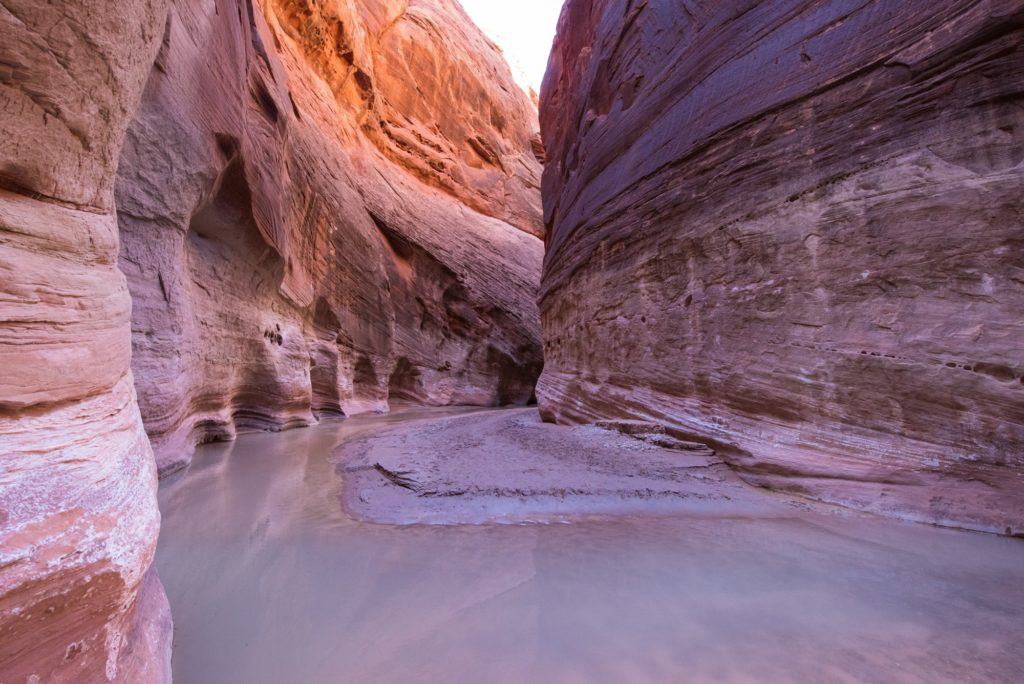
Paria Canyon Backpacking Route
You can see from the map below that there are two alternative trailheads – Buckskin Gulch and Wire Pass – both narrow slot canyons. In fact, Buckskin Gulch is considered to be one of the longest slot canyons in the world, and I’ve heard nothing but awesome things about hiking it. But for this trip, I chose to start at White House Trailhead for a couple of reasons:
- Starting from Buckskin or Wire Pass adds significant distance to the first day, and there is nowhere to camp until you reach the Paria River.
- Both Wire Pass and Buckskin are very narrow slot canyons with obstacles and often have deeper water than the Paria Narrows. Traveling through here with a big backpack makes the first day significantly more cumbersome.
- From the Whitehouse Trailhead, you still get to travel through the Paria Narrows which you bypass with the other trailheads. While not as constricted as Buckskin Gulch, the walls of the Paria Narrows close in to about 6 feet across at some points, meaning you still get to experience some deep slot canyon hiking.
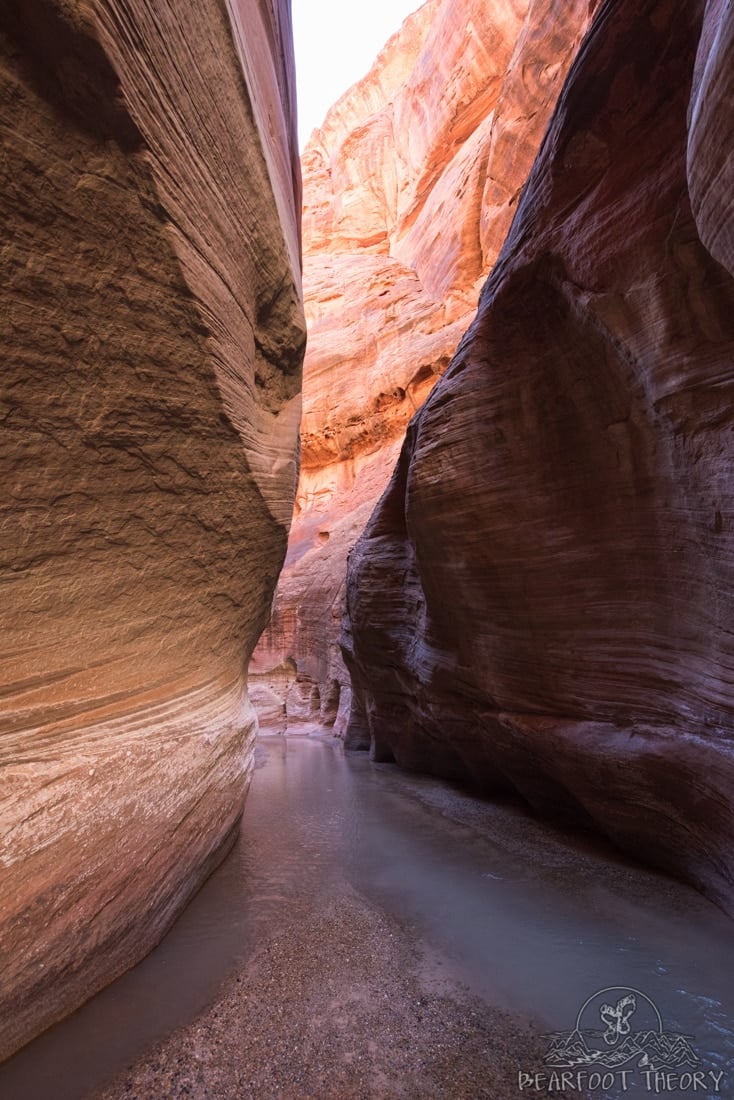
For these reasons, I decided that Buckskin Gulch will have to wait until next time when I can travel light with just a daypack. If you are set on traveling through Buckskin Gulch, starting at Wire Pass provides a slightly shorter route. Alternatively, you can hike from the White House Trailhead, set up camp just below the confluence, and then go on a shorter day hike up Buckskin Gulch from the bottom without your pack.
Click on the map below for a larger version.
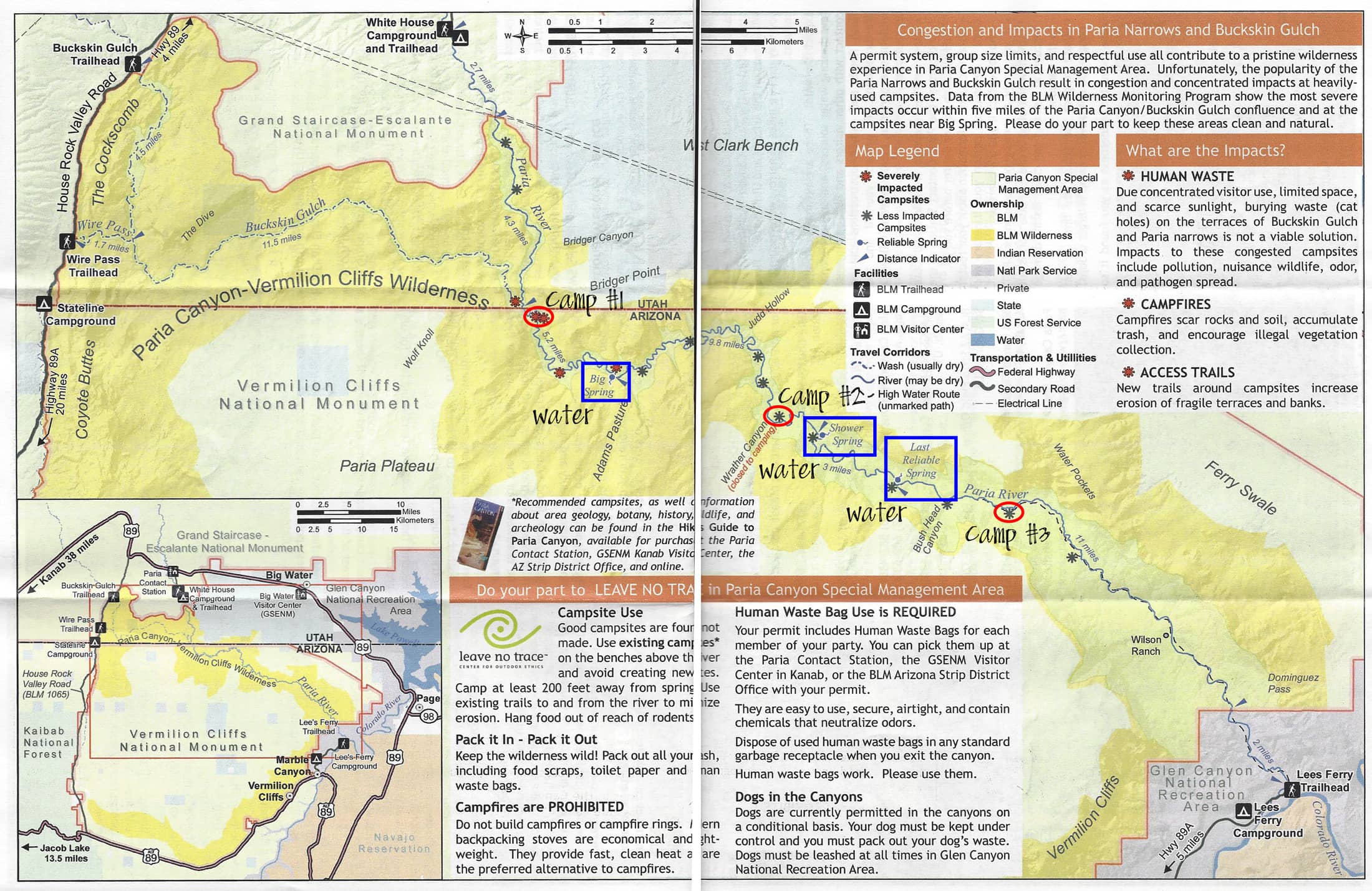
Read next: Want to hike the Wave? This amazing natural wonder is also located off of Wire Pass Trailhead. Learn how to obtain a permit in our Wave hiking guide.
Best Time to Hike Paria Canyon
Although the canyon is open year round for backpacking, the air temperatures in late spring and early fall are going to be the most comfortable. These are also the most popular times, so you need to plan far in advance to make sure you get a permit through the lottery system. The risk of flash floods is the highest in July, August, and early September. Flash floods in Paria Canyon, particularly in the Narrows, can be very dangerous since there is no high ground in the Narrows. In the days leading up to your trip, be sure to check Paria Canyon weather and if there is a chance of rain, call the Rangers station to seek their advice about whether or not it is safe to hike.

Paria Canyon Permits
Permits are required for both day hiking and overnight trips in Paria Canyon and Buckskin Gulch. Walk-up permits are available for day hiking at the trailheads (no limit on day hikers – $6 fee), but overnight permits must be obtained through the Paria Canyon online permit application system. No same-day overnight permits are granted. Permits must be picked up within 10 days of your start date from Grand Staircase-Escalante National Monument Visitor Center or Vermilion Cliffs National Monument/Public Lands Information Center.
The BLM only allows a total of 20 people per day to enter the canyon on overnight permits, and that is across all of the trailheads. There is a $9 reservation fee per group, and an additional $5 permit fee per person per day. Dogs are also allowed for an extra fee of $5 per dog per day. When making a reservation, you will reserve the number of days you plan to spend in the canyon, not nights.
For overnight permits, the reservation system opens up at 12pm Mountain Time on the 1st of every month, 3 months before the month of your hike. For example, on February 1 permits for May would open.
On the permit application website, the calendar shows you when there is availability. If a date is blue, it means there are permits available to enter the canyon to backpack on that day, and the number shown indicates the number of spaces (one space = one person) that are available. Gray dates mean there are no permits available to start on that day. For the best chance of getting a permit for the busiest spring and fall months, you should plan on being on the website right at noon on the day that permits become available.

Paria Canyon Trail Campsites
Campsites are spread throughout Paria Canyon and tend to be on sandy beaches above the river. The BLM asks that you choose existing campsites that are at least 200ft away from water and also appear to be worn to avoid creating new sites. It was pretty obvious where most of these campsites were, and you can see the three campsites I stayed at marked on the map above. The main thing to take into consideration when camping is the location of the fresh water springs, since the springs are the easiest places to obtain water. You will need to filter your water on the trail, so be sure to bring a backpacking water filter. Campfires are not allowed at any of the sites.
Our campsites were:
- Night 1: Just below the confluence of the Paria River and Buckskin Gulch (mile 8)
- Night 2: Across the river from Wrather Canyon (mile 20.5)
- Night 3: The next obvious campsite past Bush Head Canyon on the right side of the river, shown below (mile 30)

Water Availability in Paria Canyon
Water availability is something to take into account when you are planning your Paria Canyon backpacking itinerary, which might seem strange considering you are hiking down a river. However, the Paria River gets very silty, and a lot of water filters simply can’t handle the grit and can get clogged. Also due to animals that live upstream, it is recommended that if you are going to drink water out of the river that you both filter and purify it to get rid of bacteria and viruses. That means carrying both a filter, such as the Platypus GravityWorks filter, which I have reviewed here, AND a SteriPen or purification tablets.
Luckily there are a couple of reliable freshwater springs that provide a source of clean drinking water. These are seeps where the water flows right out of the cracks in the sides of the canyon walls. Some people will drink straight from these springs, but since we had a SteriPen, we decided to zap it just to be safe.
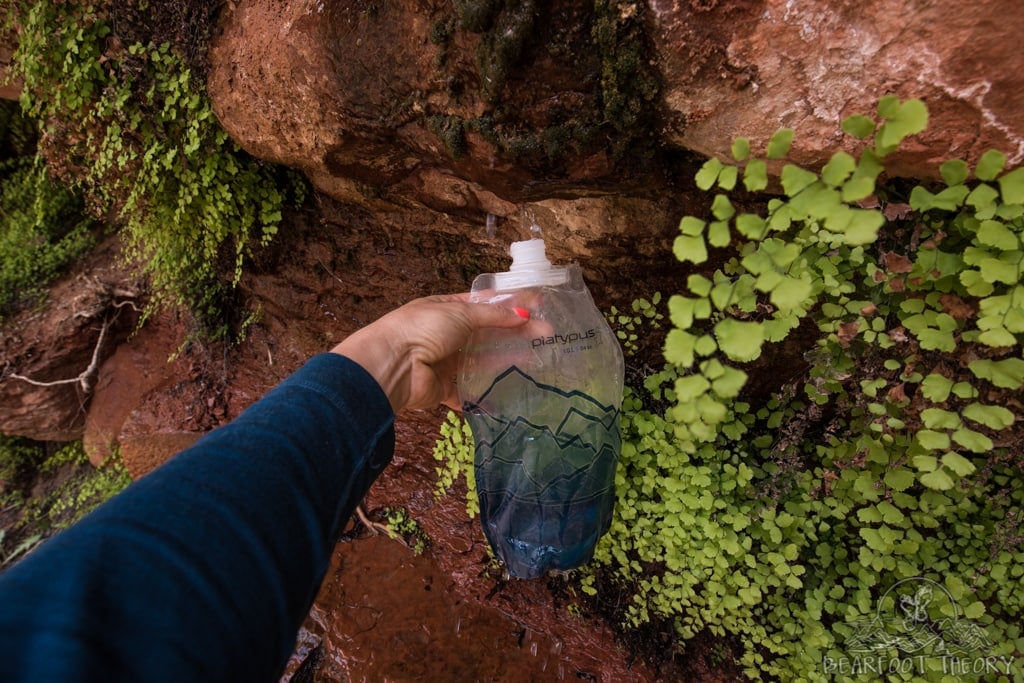
Many of the springs are easy to miss, so it’s important to be on the close look out. Lush vegetation growing out of the canyon walls is a sign that a spring might be present.
The most reliable springs when I hiked this trail a few years back are marked on the map above and are located at:
- Mile 12 – Big Springs – on the right side of the river across from a large campsite
- Mile 22 – Shower Spring – hidden behind some vegetation on the left side across from a large campsite
- Mile 25 – Last Reliable Spring – on the left side, somewhat hidden among a series of large boulders, across from a large campsite
Please note water access may have changed since I was there – always check with a ranger before heading out for the most up-to-date water information.
Camping at sites near these springs is convenient because it means you don’t have to carry water for cooking your backpacking meals. You just fill up when you arrive at camp and before you leave in the morning. However, we chose not to camp at the springs because of how they were spaced out. Instead, when we passed the springs, I filled up with enough water to drink as well as to cook with. It made for a heavy load, but for us, this made the most sense. If you camp at the Last Reliable Spring at mile 25, for example, this means you have to hike 13 miles on the last day which is something we didn’t want to do.
If you do end up having to filter water from the river, you will likely need to let the silt settle in some sort of container before running the water through your filter. Otherwise, there’s a good chance it might get clogged. We did end up filtering from the river on our last night since we camped past the last reliable spring, and my Platypus GravityWorks filter performed well.
It should be noted that you should fill up all of your water bottles at the Last Reliable Spring. Beyond that, the trail has virtually no shade and can be very hot.

Paria Canyon Backpacking
Trip Report
Day 1
From the Whitehouse Trailhead, the canyon walls start out short and wide and slowly narrow as you continue hiking down the river. The first part of the hike can be quite hot as there is little shade so if you are hiking in the warmer months, make sure to get an early start.
Around mile 4, you reach the entrance to the Paria Narrows. The towering sandstone walls in this section reach up to 800 feet high and at some points, the walls are a mere 6 feet apart. In this section it is cool and shady, and some places in the Narrows, the water can get deep following rainfall. During my trip, it was never more than knee deep. However, it is hard for the rangers to predict current water levels, so you should be mentally and physically prepared to wade through waist deep water in the case that water levels are high.
At mile 6.7, you reach Slide Rock Arch – an enormous boulder that once fell into the canyon and has formed a short tunnel. If you catch it at the right time in the afternoon, the sun beams down creating some great photo opportunities.
Around mile 7, you reach the confluence of Buckskin Gulch and the Paria River. Buckskin is considered to be the longest slot canyon in the world. Buckskin is very narrow with deeper water and has a lot more obstacles than the Paria Narrows, so most people explore Buckskin on day hikes without backpacking packs on.
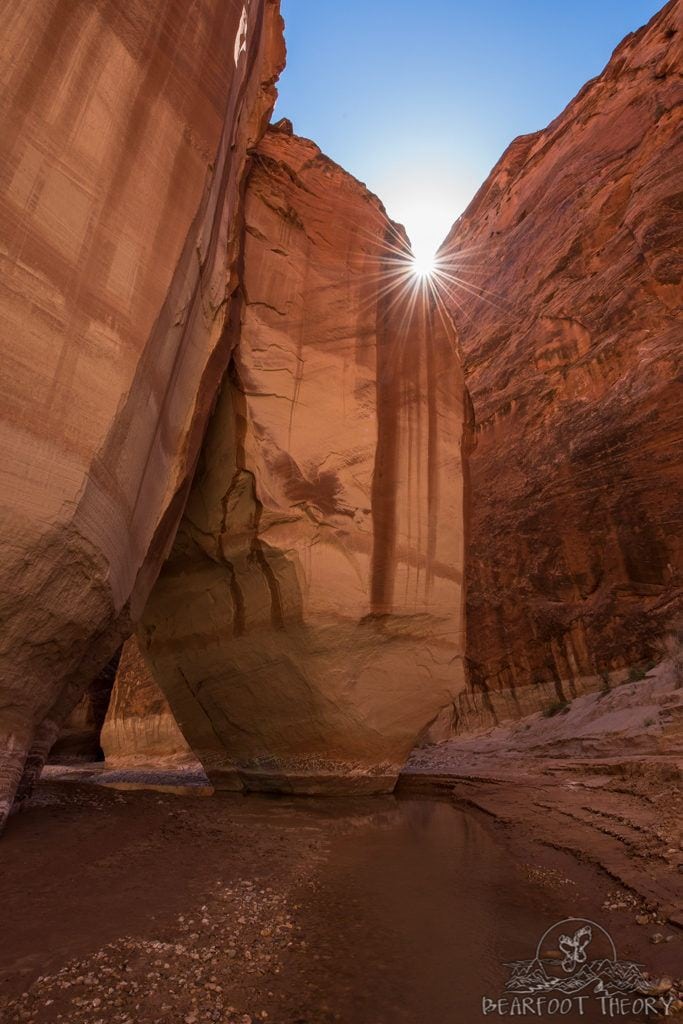
Day 2
Shortly after leaving camp, we reached the first freshwater spring. As mentioned above, most people prefer to get their drinking water straight from these springs rather than filtering from the river, but it’s always a good idea to have a backup water filtration method in case you miss a spring or it’s not flowing while you’re there.
Around mile 15, there are a series of cave-like amphitheaters that rise 650 feet above the riverbed. This was my favorite part of day 2. There are tons of beaches to stop and relax on, so make sure to take your time and enjoy it.
Just as the sun was going down, we reached the junction to Wrather Canyon. After 13 miles that day, we were totally spent and decided to set up camp on the beach across the river.
Read next: Best Backpacking Trips in Utah

Day 3
On Day 3 the terrain began to change – the canyon broadened, but the river features got more interesting with rocky obstacles, deep holes, and small cascades. It was really neat to watch the canyon slowly transform over the course of the trip.
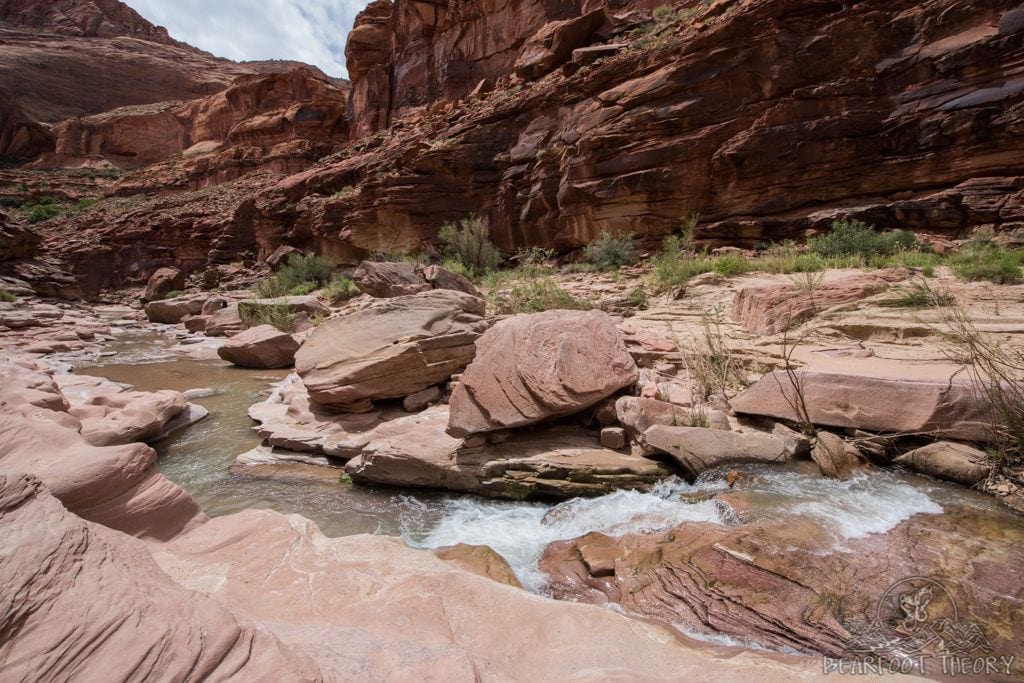
Many people choose to camp at the last reliable spring at mile 25, but that leaves 13.5 miles for the final day. That didn’t sound too appealing to us, so we filled up at the spring and kept going. Using the map provided by the BLM office, we decided to stop at one of the last good spots on the river, around mile 28 or 29. We found an awesome spot on a beach on the right side of the river with a perfect sunset view.
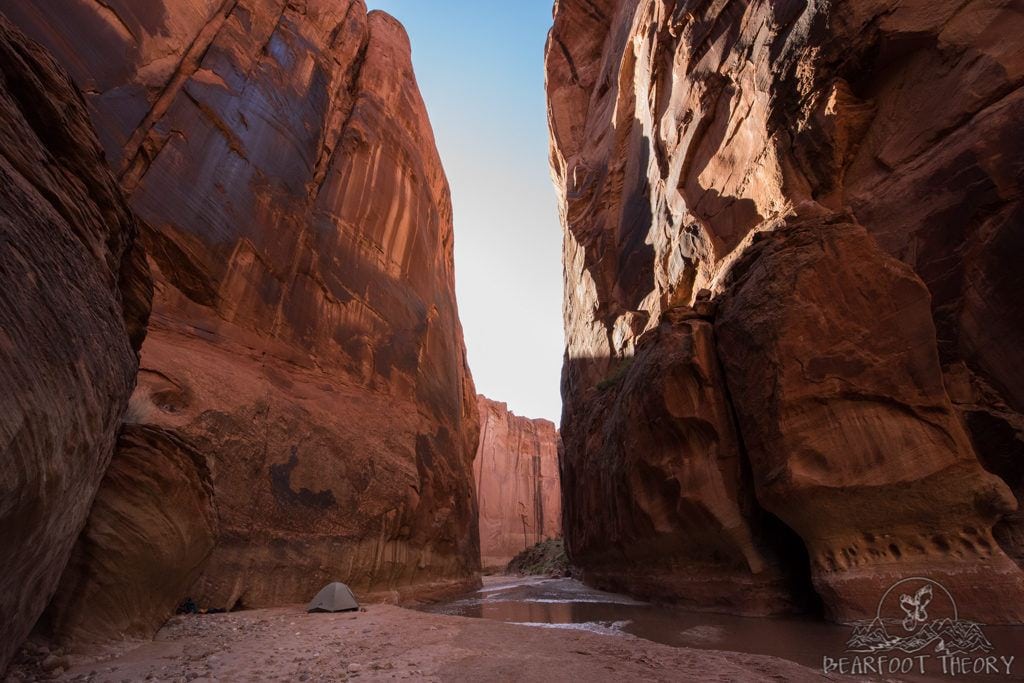
Day 4
The final day the landscape takes on more of a desert feel. The trail is hotter, drier, and sandier and with the canyon broadening, sun exposure can be intense so be sure to pack sun protection. That said, the views on the descent to Lee’s Ferry were gorgeous, and the variety in the scenery kept things interesting.
Around mile 31.5, there are a series of boulders on the left side of the river with petroglyphs. While the trail does cross the river a few times over the last several miles, most of your time is spent out of the water. The trail also becomes more prominent since you are no longer hiking down the riverbed. Eventually, you come to an old ranch, indicating that you are close to the trail’s end at Lee’s Ferry.
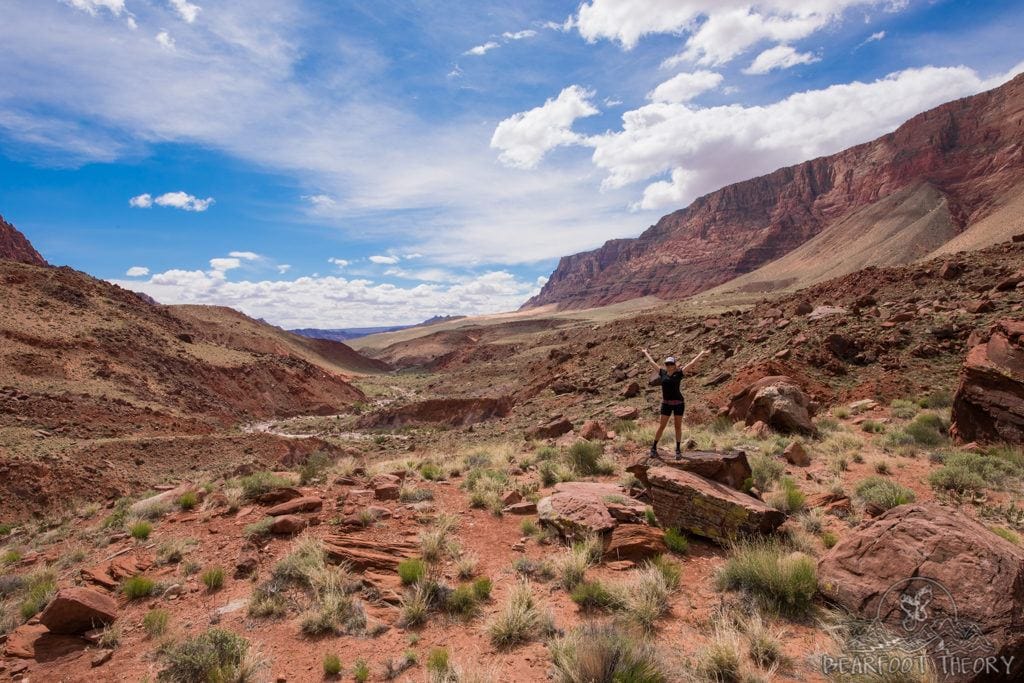
Gear for Hiking Paria Canyon
Start with this backpacking checklist and desert hiking clothes guide to pack for Paria Canyon. In addition to a map and your normal backpacking essentials, there are a few extra gear considerations for canyon hiking.
Hiking Shoes
The Paria River is cold and full of pebbles so I would not recommend water sandals for this hike. Instead, you’ll want to wear tennis shoes or a pair of lightweight, non-waterproof hiking boots with a closed-toe and closed-heel. Waterproof hiking shoes will fill up with water while non-waterproof ones will allow water to go in and out. The Oboz Katabatic (non-waterproof version) are a great option for this hike. I also recommend pairing your shoes with some neoprene socks to help keep your feet dry and prevent blisters.
Dry Bags
On my trip, the water was never more than knee-deep, but the river can be waist-deep after periods of heavy rain. In order to keep your essentials dry, you have a couple of options. First, you can invest in a few lightweight dry bags, such as these Sea to Summit Lightweight Dry Sacks. They come in a variety of sizes, and you can pack your sleeping bag, clothes, and electronics inside. Or for a cheaper solution, you could line the inside of your pack with a garbage bag and then pack all of your gear inside of that.
Trekking Poles
While most of this hike is flat, trekking poles can help stabilize your footing when crossing the river and during sandy sections of the trail. Trekking poles also keep stress off of your knees, which is important as you hike with a heavy pack on.

Water Filtration System and Bottles
Water Filtration
I am a huge fan of the Platypus GravityWorks filter system. All you do is fill up the bag, then hang it from a tree and let the water flow down through the filter….no pumping required. The filter worked perfectly since the dirty water bag provides a place to hold the water while the silt is settling to the bottom. If the water has a ton of sediment, then I’d recommend pre-filtering it using a bandana so you don’t muck up your filter.
Water Purification
There are a couple of options for purification. The cheapest, lightest, and easiest are purification tablets. These get the job done, and they’ve also come a long way in regards to taste. Another (more expensive) option is the SteriPen. Just swirl the tip of the pen around in your water bottle for a minute, and it kills any viruses that might be present. The only thing about the SteriPen is it works best with wide-mouth water bottles, like a Nalgene, and it also runs on a rechargeable battery. This means you need to charge it up before you leave the house or bring along a battery pack or small solar panel to charge it in the field.
Water Bottles/Reservoirs
I would recommend carrying a 3L hydration reservoir, as well as a few extra lightweight water bottles. Having the capacity to carry extra water will provide you more flexibility in where you can camp. For this, I recommend this Osprey Hydraulics reservoir. Just make sure the lid is on tight and test it before you put it in your bag. For the extra bottles, I like the Platypus 70oz Platy Bottle. I brought along three of these because they weigh practically nothing and can be rolled up when not in use. The only thing to keep in mind about these is if you plan to use a SteriPen, it won’t fit through the mouthpiece.
Paria Canyon Hike Transportation
Because this is a one-way hike, you will need to do a car shuttle so you aren’t stranded when you reach the end. My friend and I met in Page, Arizona, and then I followed him to the trail’s end at Lee’s Ferry to drop his car. We stayed the night at a motel in Page and the next morning drove to the White House Trailhead.
When you pick up your permit, it will come with a parking tag. Make sure to leave this on the dashboard of your car at the White House parking lot. If you prefer to camp the night before you hike, there is also a first-come, first-serve campground at the White House Trailhead with a pit toilet, picnic tables, and fire rings. Sites are $5 each and America the Beautiful and Federal Recreation Lands Senior Passholders receive a 50% discount. Drinking water and trash disposal are available at the Paria Contact Station at the northern end of the campground access road – I recommend filling up your water here before starting the trail.
If you do not have two cars, there are shuttle operators who can help organize your transportation for a fee. Seeking Treasure Adventures and Trails End Shuttle are two examples.
Here are driving directions from the White House Trailhead to Lee’s Ferry.
Other Paria Canyon Considerations
- The Paria Contact station will provide each hiker with wag bags that you are required to use to pack our your poop. If you choose to bring a dog, you must also pack out their waste.
- At mile 20.5, there is an optional 25-minute side trail up Wrather Canyon that leads to Wrather Arch. We didn’t do this, but I’ve heard it’s quite impressive. No camping is allowed up Wrather Canyon.
Backpacking Paria Canyon was my favorite desert trip to date, and with the colorful scenery and lack of crowds, Paria Canyon will not disappoint!
Have you backpacked the Paria Canyon in Utah or plan to?
Let us know in the comments!

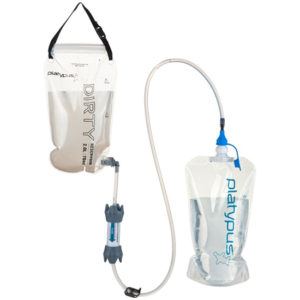





Amazing guide. Thank you for creating and sharing. I love your night photos of your tent under the stars! This looks like a must do hike.
Thanks Virginia! Glad you enjoyed it and appreciate the compliment about my night photos! Paria is definitely one to add to you list if you are traveling through the area. Thanks again! Kristen
Awesome! Thanks for putting this together. Maybe I missed it but how did you store your food overnight?
Hi Brad, I’d recommend carrying your food in an Ursack which is a bag that will keep critters (squirrels, mice, chipmunks, etc) out of your food.
really enjoyed your trip! Loved the petroglyphs on day 3! A-maz-ing!
Thanks Kelly! If you have any questions about Paria Canyon, just let me know! -Kristen
What books/map guides did you use for the trip?
Hey Celeste – The only map we had was the one I put in the blog post which was provided by the BLM office when we picked up our permit. The trail is very easy to navigate…the only thing you really need to watch out for is the fresh water springs. Before the trip, I also used this Utah hiking book which I really like: http://amzn.to/1f9LfGf
Inspired to trek this in summer 2016! Question though: what temp-rated sleeping bag did you use for the trip? Could one get away with a 3 season bag or will a 40 + bag be that much more comfortable?
Hey Alex – For Paria in the summer, it’s going to be hot. I think a three season bag would be ok though…probably not worth investing in a 40 degree bag just for this trip. You can always strip down, unzip, etc. I used this bag on the trip, but it was in April: https://bearfoottheory.com/product/rei-joule-sleeping-bag/
Hope that’s helpful!
I really enjoyed your blog post on hiking the Paria. I’ve hiked it twice, both times starting at Wire Pass and through the Buckskin. It’s beautiful either way but honestly, you missed the best parts! Buckskin is simply amazing and Wrather Arch is not to be missed. I did the entire 46 miles in 4 days but as you mentioned, it’s slow going even though it’s all downhill. Part of the hike is slippery boulders and there is the ever present quicksand. I averaged just over 1 mph! Next time I’ll take 5 days, 4 nights so I can “smell the roses” a little more.
One of your commenters asked about maps. I strongly suggest reading Kelsey’s book on the Paria. He’s written multiple books on the area and is the expert.
Hey Robert – I’ve heard amazing things about Buckskin…I would have loved to do it. And Wrather Arch too. I have a strong feeing I’ll be going back there at some point for round 2…so I’m definitely planning on working these things into my next trip. And thanks for the tips about the map/book! Appreciate the support and if there are ever any topics you’d like to see covered on my blog, feel free to get in touch!
I have to agree with Robert. I hiked Wire Pass to Big Spring this past summer and Buckskin Gulch was by far the most amazing part. The logs jammed across the slot 20 feet above your head make for some really incredible photos. I have also done Antelope Canyon and I think Buckskin takes the cake for best Slot Canyon. It receives a tiny fraction the number of visitors and the cesspools provide some memorable moments. Definitely try and get back to do this one Kristen! Otherwise, I must say this post was very helpful in terms of resources before my hike. I loved the map you provide and the information regarding water. We brought over a gallon per person for a 3 day hike and this was not quite enough.
Thanks Jake! I’m definitely planning on getting back there this spring. Thanks for the motivation.
The Buckskin has no potable water so we carried 5-6 liters each. Then walking from shower spring to Lee’s Ferry was no problem because we had sufficient water. We did try filtering once with clogging success. Even in the hot summer, the deep canyon stays relatively cool. The hike to White House and Lee’s Ferry gets hot though. A 3 season bag would be fine from April-Oct. I visited Coyote Butte and White Pocket last February and the nights were below freezing because our water froze.
Kristen, I am looking at doing this trip in December but it would be a solo trip and I don’t want to spend $100+ on a shuttle back to my car. Do you think it would be possible to do a round trip similar to what you did? Camp 1 and Camp 2 and then back to White House trailhead or something similar?
You could do that, but you’d be missing out on some of the scenery. And the first 4 or so miles from White House are pretty uneventful.
Hi Kristen. I am in love with your website and instagram! My boyfriend and I hiked Paria in July and your guide was an incredible source of information during our planning stages. Keep up the great work! Would you believe I left my NRS socks at home in Dallas? That was pretty awful, as anticipated. The day after our hike we kayaked 7.5 miles upstream on the Colorado River using LF as our input. We stopped occasionally to explore, fish, and floated back downstream in no time. If you have the time/energy to spare, it was the greatest kayak trip we’ve ever done. The original plan was to go further upstream to Horseshoe Bend where we’d make camp but no. Your arms will be beyond exhausted. Even in hot July the water is about 50 degrees and clearer than you’d ever imagine. Such a cool thing to see the giant boulders and huge schools of fish many feet beneath you. We rented our kayaks for $45/hour from a small outfitter in Marble Canyon.
Your writing has also inspired one of my next adventures for late 2016 – the John Muir Trail. I have never been much of an outdoor adventurer and Paria was my first thru hike. I’m hooked! In May 2016, I am walking the Frances route of the Camino de Santiago de Compostela – a 550 mile trek through Spain. Looking forward to the JMT later next year. Thank you for documenting your travels and writing to inspire!
Hey Shae –
That kayaking sounds amazing. I’m definitely going to check that out next time I’m in the area. And I’m so so so pumped to hear about your plans to hike the JMT. You are going to have an amazing experience and I can’t wait to hear about it. Please come back and share it all with me. Cheers and happy holidays! Kristen
Kristen, I can’t thank you enough for your information on the Paria Canyon hike. I’ve searched for as much information as I can since this is a dangerous (Buckskin Gulch portion) and somewhat difficult hike. I had lots of questions in my mind since I have friends that have completed the hike from Wire Pass to Lee’s Ferry. Your blog answered all my questions and even more. You made me feel much more confident that our group hike in May will be successful. Our group is getting extremely excited about visiting such a spectacular place. It brought a smile to my face to see you are also from Utah. Keep up the great work.
P.S. I’ve already signed up for your Barefoot Theory emails.
Hey Dallas! Thanks so much for the kind words. You are going to have an amazing time in Paria…you’ll have to come back and tell me about it! Cheers, Kristen
Thanks for tips Kristen. We are hiking the Wave in July and looking for additional hikes. Blog extremely helpful!
Kristen – thanks for the great compilation of information. My daughter and I are planning to apply for a permit to hike for four weekdays in late October. It seems like the pressure for permits would be waning by then, and probability ought to be better. What has been your experience? Thanks. Paul
I got my permit when it became available in the lottery. I think the trail is becoming more popular, but I think you shouldn’t have a problem in October. Just make sure you apply when the lottery opens.
Hey Kristen,
Your posts are always so informative! Thank you for being so thorough! I’m doing Wire Pass-Lee’s Ferry end of June and was curious what you would recommend for tent/sleeping bag and even clothing? The temps look like they are in the 70s-80s but I have no idea how to think about temps inside the canyon? Is it much cooler? Also, did you bring any bug spray type thing?
It would be really useful if you can write about the boring details about what to have in your first aid kid, carry a knife etc. 🙂
Thanks again!
I would bring a tent in case it rains. For a sleeping bag, you probably don’t need anything to heavy as it should be pretty warm. It is cooler in the canyon, but averages in the end of June should still be comfortable. There were no bugs when I did it in April, but June may be different.
Check out this page for some of my favorite gear:
https://bearfoottheory.com/gear/
Thank you for your informative article. I’m thinking of doing the hike from Wire Pass to Lee’s Ferry the wk of July 4th. I’m somewhat concerned about the risk of flash floods and high temps that late than, as well as water. I was also told that the river itself may by essentially dry, at least until rains come. Do you have any thoughts on hiking at that time?
I didn’t do Wire Pass, but flash flood season really gets going later in July. The best bet is to look at the forecast and call the rangers station to get current conditions prior to your trip.
Hi—My wife, Megan, Ollie the Adventure dog and myself just got back from this hike about a week ago. I used your blog to convince my wife that this was the hike for us before we left and we had a great time. If anyone is considering doing this hike and is reading this message, I have two pieces of advice. 1. Do it, this is one of the best multi-day trips I have been on in North America, and 2. After the big fall storms of 2016, the section of canyon between miles 25-28 is a mess. It took us about 3 hours to navigate all the flood debris in the canyon. At mile 28 I highly recommend taking the high water route. Its no where near as pretty or interesting hiking as the canyon floor, but you will save yourself hours of misery otherwise.
Awesome. Glad you enjoyed it and thanks for the tip about the high water route.
Hi
Great guide! My family and I are doing the hike in mid march over 4 nights. I have a few questions.
1. How were your feet at the end of the hike? I heard that your feet and shoes are destroyed after.
2. I have the platypus gravity filter. Did you use any prefilter and/or Alum to help the silt settle?
3. I am hoping to camp just below the confluence of the Paria River and Buckskin Gulch. Did you carry water the first day or filter from the Paria? The map does not show a spring.
Thanks
Eric
Hey Eric,
1) Feet were ok. I wore tennis shoes and neoprene socks. Just make sure you have something dry to change into at night (socks/sandals, etc)
2) We lucked out and the water was really clear. You might want to bring a bandana or something else to filter the silt out first. We also had a steripen and that worked great for the springs.
3) I believe we carried water from the trailhead.
Have fun!
Bill, How did the dog do on the hike? I am most curious about the depth of water, quicksand, and the rocky section around mile 27. We would LOVE to bring our adventure dog with us.
A water filtration system is a nice suggestion. Using purification tablets is simple way to meet this need, as you shared.
Such a great read! You mention that most of the trail is flat? Is there an elevation gain? My friend had an extra permit and asked me to join her in two weeks! Just wondering how physically fit I need to be before I go.
You are gradually descending throughout the hike. With a decent level of physical fitness you should be fine. Have fun out there!
Hi! Do you know what CFS the Paria was running at when you went down in April? How about night temps in April in the canyon? Were you chilly at night?
Hey Sarah – unfortunately i don’t know what the CFS was. Night temps were pretty cold but we lucked out with the weather. Best bet is to check the weather before you go and pack accordingly since April can be unpredictable.
Great guide and very nice photos! Very interested in the hike, but hesitate that if Thanksgiving will be a good time to do it. We will be needing some water wading pants I assume? I know it’s by nature hard to predict the water level, but do you by chance have any info of that during late Nov? Like average or so..
Thanks for your time!
Hi – question about doing the short day hike in Buckskin. Is there a lot of water-wading through cesspools for this hike? We are not planning on doing the giant version of this hike. Just the short version. I know there is a little scrambling involved but how much water are we talking? Enough to rent water boots? Thanks! Kathryn
Whether there is water all depends on the timing of the last rain. There was no water in Buckskin when I went there, but I’ve seen photos of people wading through knee and waist deep. I wouldn’t wear water boots. Boots are only waterproof until the water goes in over the top. I would wear tennis shoes instead with neoprene socks that will dry out quickly.
I’m planning a Utah/Arizona road trip for the end of June and your blog posts are so helpful! How do you think the heat would be for this trip at the end of June/beginning of July? Do you have other recommendations for day hikes/overnights while already in this area? Thanks!!!
Hi Rowan, it’ll be pretty warm by then but you can always start early in the morning for hike late in the afternoon & into the sunset to beat the heat. It definitely will be feasible just make sure you have plenty of water. Have you checked out our Ultimate Utah National Park Road Trip Itinerary? https://bearfoottheory.com/utah-national-parks/?
Hi Kristen,
After reading your blog posts I have planned a Paria Canyon trip for this June. I am scheduling a van pick up since we only have one car, and am wondering- doing the trek in 4 days, 3 nights as you did, about how long did it take you to hike out the last day? I am trying to guesstimate when the van should pick us up. Thank you!
thanks for the great info. looking forward to a Sept. trip. What did you do with securing your food? Were vermin a problem?
Great, great summary. Thanks so much. And great blog site, too. I will be doing my first canyon trip in Paria and Buckskin this October. I have my permit and seem to be gaining good information. I’ve set up a shuttle. I’m just wondering about car safety at Lee’s Ferry. I want to assume all will be well.
don’t worry about car safety. we’ve left vehicles (with plenty of stuff in them) at that parking area as well as the nearby campground and also at the airstrip parking for periods longer than a week with no problems.
marble canyon lodge is right up the road from lees ferry and was perfect place to decompress and reflect on the hike on the final night.
know your equipment,
don’t over pack.
i’d suggest two forms of water filtration/purification.
water socks that kirsten mentioned were perfect….. no blisters, no prune skin
after the confluence, we only saw two other parties of two for the next thirty miles.
it was great.
planned to post more photos and comments about our trip but haven’t got around to it yet.
but there are a few here…. http://outtakesfromanescapeartist.blogspot.com/
be safe
have fun
elliott
Hey! Great guide for the Paria. I just finished a trip through there and would love it if you would add something to your list for me. Wide Baskets on your hiking poles. In the event you encounter quick sand the wider basket will be a huge help to keep you above the muck longer. Thanks for writing about this trip. There really arn’t that many resources out there.
I was thinking of doing Buckskin Gulch/Paria Canyon after the Phish shows in Vegas at the end of the month. Should I be concerned about doing them solo or is that I’ll-advised? Thank you!
Hi, random question: are there trees at the first campground (from Whitehouse to the confluence)? The reason I ask is because I am bringing my dog, and usually I affix his leash to a tree at night time.
Great review of the Canyon!
Thanks!
Hey! Thanks for all the information here! I would like to add a bit of info on logistics based on my good experience. For a shuttle, I highly recommend Steve Dodson at Paria Outpost (www.paria.com). He’ll want to meet by 3 pm at Lee’s Ferry the day prior to your hike. You’ll leave your car there and he’ll drive you up to White House. We got our permits in Kanab on our way to Lee’s Ferry.
In addition, if you want the most in-depth local information on the hike or anything else about the area, these are the folks you want to talk to! Very friendly and very affordable.
Hello Kristen. Greetings from Spain. I have been looking for information about the vast areas explored by Spaniards throughout the sixteenth and seventeenth centuries in the North American territories, and indeed most of the names that you still use there to designate the topographic accidents are of Spanish origin. (Los Angeles, Mesa, Mosquito, Paria, Colorado, etc etc). Many of these places were discovered by exploration groups that radiated their steps from Santa Fe, and most of these incredible places have recognized the commanding officer who discovered it and also many times gave name. However, I find no bibliography that explains the origin of the Paria Canyon (which is a Spanish word meaning low social class or unfortunate). Taking advantage of your commendable love for that region, I would like to ask you if you know what explorer gave name to that area and why its name ?. Thank you so much. Ignacio
Kristen,
THANK YOU for your incredible write-up for this hiking trip you did through the Paria Canyon. What an adventure! You shared amazing photos! I can’t believe you captured that many stars in your photos, either! What kind of camera did you use? I really appreciate the depth of information you shared because I was trying to figure out if my husband and I wanted to do this hike. We recently walked through the Narrows, as well as Kanarra Falls (have you gone there? If not, definitely check it out because in the slot canyon there are two pretty waterfalls as your destinations! ) After reading your article, I now know that we will pass on this trip since it would take 4 days and my husband works full-time on the road. Thanks for sharing your adventures. It really helps those of us that want to follow in your footsteps. So thanks for taking the step yourself to do this kind of writing. Keep up the adventures and the writing!
–Maryellen
What an amazing synopsis of this incredible hike. I did it years ago, and am now a Scoutmaster. I’m looking to take my scouts on this one. Can’t wait. We will use your blog here as a primary reference. Thanks again!
Glad to hear it Mark! What an incredible opportunity for kids. Thanks for sharing your love of the outdoors with your scouts!
We are going to be driving through the Paria in July from Phoenix on our way to the Canadian Rockies. We hope to spend a night or two and explore the Paria. I have a couple questions. 1) There are only a handful of sites at White House Campground. Do you think we will get one if we arrive around 5pm? 2) We will have our 10 year old with us. Is there a short hike we can do? 3) will the temperature be good for camping?
Hi Weiru,
Sounds like an incredible trip you’re planning! Like you said, there are only a handful of sites at White House Campground so it would be best to arrive early in the morning if possible. But, you could get lucky and score a site. If you don’t get one there, check out https://freecampsites.net/#!Kanab,+ut to find nearby public land that you could camp. The temps will be very warm in the day time and comfortable at night. It will be fine for camping but stay hydrated – bring a lot of water and drink it because the scorching sun and heat can dehydrate you fast. Also, keep in mind that you’ll be in Utah during monsoon season so make sure you camp in high places, not down low in any canyons or arroyos. For good family hikes, check out Wire Pass Trail and the Nautilus Trail. Check out some of our favorite hikes in Utah: https://bearfoottheory.com/best-hikes-in-utah/ Have a great trip!
Looks incredible! Definitely adding to my list of places to go!
Thanks for this awesome guide! It’s very helpful. We’re hoping to do this hike in a few months when things are hopefully settled down. I’m thinking to start at Lees Ferry and end at Wire Pass trail head. Logistically, this makes more sense to me because you can pick up your permit and stay at one of the campgrounds the night before and the next day get shuttled to Lees Ferry and hike back to the car at Wire Pass. Do you know of any shuttles that will take you from Wire Pass to Lees Ferry? What’s your opinion about this route? I see most people doing it the other way but because we have to pick up our permits in person, it would be easier. Thanks in advance!
Question!! Newbie backpacker here! Should I buy a slightly bigger pack so my sleepbag can fit inside? I guess I’m concerned about it getting wet? Thank you! Great Blog
Hi Carl! Do you use a compression sack for your sleeping bag so that it stuffs down smaller? It is nice to have it inside the pack so that it doesn’t get wet, especially if it’s a down sleeping bag. You could also get a waterproof stuff sack if you want to strap it to the outside of your pack.
Thanks for the great intel. Just got my permit for April 10-13, 2021 and ordered some waterproof socks. Hoping it’s not too cold at that time.
Have fun!
Any thoughts on doing it in reverse? Starting from Lee’s Ferry and hiking up the Paria and then through Buckskin Gulch up to the Wire Pass trailhead. I ask because we are thinking of going that way so we get the less interesting part of the hike done first and have the best of it, the slot canyon, at the end.
We are interested in doing a day hike in September. What trail head would you recommend for and in and out? and secondly, where are the best places to stay?
Love your blog!
Wire Pass is a popular out-and-back day hike. You can also call the Paria Contact Station for more day hike ideas and places to stay in the area.
Did Paria almost 20 y ago and still relish the memories. We camped our first night out by going up Buckskin Gulch several hundred yds to where it opens up with a huge sand mound ideal for peaceful sleep. Surrounding walls were a raven populated echo chamber. Magical
Hi there! Thank you for all this info!
Just want to make people that are attempting this hike to be hyperaware of flash floods any time of the year. Check the watersheds and if there is ANY rain in a 100 mi radius 24 hours prior, do not go in!
We were incredibly lucky and escaped a 12ft water wall by so little. It took the river 14 hours to go back to hikeable levels and then another smaller wave came through as we were about to hike out of our safe spot. We were stranded for 24 hours and had to be airlifted out and our gear was left behind.
Bring a satellite phone with you! It’s money well spent! Do not leave camp without basic survival gear (we went to the spring as a day hike, but fortunately we had basic gear with us). Look for high ground at all times while hiking and make a mental escape route.
It’s a beautiful place for sure! Just be aware of the dangers.
Hi Emma – thanks for sharing your experience & wow, I’m so glad you made it out safely! That is a really scary situation but it sounds like you handled it well and were prepared with the right safety gear. We definitely recommend checking the weather and calling the ranger station to ensure a safe hike.
This is the best write-up for Paria Canyon I have read yet. Well done Kristen Bor.
We did it in 2014 Buckskin to LF in 5 days. The best guidebook for reference we found was “Hiking and Exploring the Paria River by Micheal R. Kelsey”. It is extremely detailed so that and talking with the rangers at the BLM office made it so safe.
We got dropped off by the shuttle person the night before and left early in the am. Having a tent was a must. The gnats at Buckskin campground would have eaten us alive without it. We mostly slept outside. Paria Canyon was not near as well known as it is now. When we went and told people about the trip no one knew it existed, maybe that is a good thing.
Kristen recommends NEOPRENE socks which are a must. I would add sock liners. They dry out easily overnight and really protect your feet that are going to be in water for a good portion of the time no matter when you go.
Back then there was a lottery at the closest BLM office for the Wave. They saved a few spots for visitors to apply for the day before. Luckily enough we got in. Try it if you have the time. You will never experience anything like it again in your lifetime.
Hiking Paria Canyon was the most amazing trip in so many ways, hearing a Raven echoing through the canyon, days of being alone in nature, Wrather Arch, sleeping under the stars, petroglyphs, and most of all the mind-blowing layers of geological formations.
Hi Jeannene, thanks for the kind words and your trip report/tips! You’re making us want to return to Paria Canyon again 🙂 It really is a special place!
There is a campsite in the Buckskin but it’s very small for only one tent about a quarter mile before Buckskin meets the Paria. It’s on top of a large little hill.
Thanks for the tip, Gary!
Hello Kristen. I am curious about the amount of water in Buckskin/Paria at the end of April. Is there a snowmelt/runoff through that area? I already have a permit, but given the crazy winter that Utah has had, I am curious. Thank you. Doug P.
Hi Doug, I’d recommend calling the local ranger station to get an accurate assessment of the water situation. Best of luck & enjoy your trip!